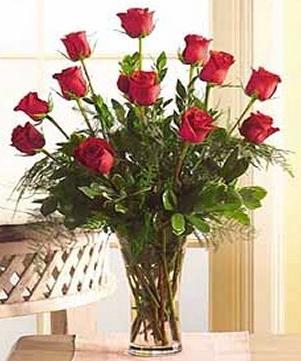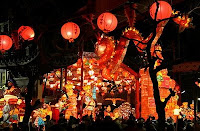Flowers and indoor plants
African Violet – (Saintpaulia ionantha) (Gesneriaceae) Fuzzy leaves, thick and fleshy, oval to heart shaped with smooth or ruffled edges; flowers in clusters with 5 or more petals, different shades/combinations of white, blue, and red.
Ageratum – (Ageratum houstonianum) (Asteraceae) Tassle flower, white, pink, purple flowers; alternate leaves, ovate (egg shape) to triangular, shaggy with hairs on both sides.
Amaryllis – (Hippeastrum hybrids) (Amaryllidaceae) Trumpet flowers; long, wide fleshy leaves; large scaly bulbs.
Bachelor Buttons – (Centaurea cyanus) (Asteraceae) Alternate leaves, lower leaves entire with few teeth, petioled; upper leaves entire with gray pubescence. Flowers: usually blue…..sometimes purple, white, rose, red, deep wine.
Begonia – (Begonia sp.) (Begoniaceae) Erect or trailing, sometimes climbing. Usually succulent in texture. Leaves are simple, alternate, highly variable in size and shape, characteristically asymmetrical with or without hairs.
Canna – (Canna x generalis) (Cannaceae) Plume-like flowers; large, simple leaves often variegated are alternate to spirally arranged with entire margins; fruit is a rough, three-valved capsule.
Celosia – (Celosia sp.) (Amaranthaceae) Plume flowers or flattened crest (cockscomb), color varies from red to yellow; leaves alternate, fleshy stems with color like the flower.
Chrysanthemum – (Chrysanthemum x morifolium)(Asteraceae) Leaves: simple, alternate, lobed, entire to coarsely toothed, often thick and pubescent with strong fragrance. Flowers: heads of various sizes and shapes, clustered with disk and ray florets; many shades of white, yellow, pink, bronze, and red purple.
Coleus – (Solenostemon scutellarioides) (Lamiaceae) Freely-branching, densely-foliated plant. Leaves of color, simple, opposite with margins which may be crenate, serrate, undulate, lobed, etc.; always have square stems which become woody with age; mint family. May have small bluish flowers on spikes.
Columbine – (Aqualegia x hybrida) (Rannuculaceae) Leaves dissected by 3; claw-like flowers in a variety of color combinations.
Cosmos – (Cosmos bipinnatus, c.sulphureus) (Asteraceae) Flower heads 2-3” across, rays 3-toothed at apex, ray flowers pale gold or golden-yellow, disc flowers yellow.
Crocus - (Crocus) (Iridaceae) Leaves: almost grass-like, dark green, curved, and often with a silver-white stripe down center of each leaf; leaves generally shorter than flowers. Flowers: color varies from white to purple; close at night and remain closed on cloudy days; star-like when open in sunlight. Very small, rather flat bulb.
Cyclamen – (Cyclamen persicum) (Primulaceae) Heart-shaped, serrated leaves with most of leaves veined in silver. Dainty flowers above foliage, no fragrance, nodding. Petals turn back as though flower is inside out.
Daffodil – (Narcissus sp.) (Amaryllidaceae) For trumpet daffodils, leaves are basal, straplike, glaucous green. Flowers usually yellow, but can be white or combination. Bulb: large, scale-like covering; new bulblets form at base of bulbs.
Dahlia – (Dahlia hybrids) (Asteraceae) Leaves: opposite or whorled, simple to pinnately dissected or bipinnate, serrated margins, rounded tips. Flowers: heads horizontal or sometimes nodding, 2-3” across but much larger in double forms; heads in 2’s or 3’s, but only 2-8 on a stem. Flower color varies with cultivar.
Daylily – (Hemerocallis sp.) (Liliaceae) A clumping perennial herb, spreading by fleshy rootstocks which may be evergreen or deciduous. Leaves: more or less linear, wider at the base and tapering gradually to the tip; V-shaped with crease. Flowers: 6-petaled, funnelform to campanulate, born in clusters; various colors.
Dianthus – (Dianthus sp.) (Caryophyllaceae) Evergreen foliage forms a mat-like growth. Gray leaves are 1-4” long, narrow, linear acute and rigid, creating a prominent midrib; margins are finely minutely serrated. Flowers are fringed, single, to semi-double, 1 ½” across, and fragrant in colors of rose, pink, white, or bicolored with a darker center.
Dracena – (Dracena sp.) (Agavaceae) Evergreen houseplant with corn stalk looking stem. Tough, sword-shaped leaves which are narrow to 4” wide, some with white, yellow, or red stripes along margins.
Dumbcane/Diffenbachia – (Diffenbachia sp.) (Araceae) Herbaceous evergreen perennial with thick stems. Large leaves are alternate, usually with white markings or patterns which have a very striking appearance. Petioles are long and cover the stem. Flowers are in spadices with thick spathes.
Ficus – (Ficus sp.) (Moraceae) Evergreen houseplants from trailing, creeping varieties to tree types. Leaves can be thin heart shaped, leathery pointed, waxy, or shiny, solid light or dark green or variegated. Creeping fig, rubber plants, and benjaminas are some of the more common ones.
Geranium – (Pelagonium x hortorum) (Geraniaceae) Leaves are orbicular, undulate and coarsely crenate with a spicy scent. Flowers are in rounded umbels four to six inches across. Individual flowers are five-petaled in reds, pink, white, and salmons.
Gladiolus – (Gladiolus x hortulanus) (Iridaceae) This perennial herb grows from a corm and has erect, unbranched flower stalks. Simple leaves are linear, sword-shaped or cylindrical. They are often rigid with a somewhat papery texture and have prominent parallel veins. Flowers are large (up to 4” across), 6-petaled, (2 rows of 3 petals). Upper three segments are larger than the lower three. Flowers range in color from yellow, white, orange, red, lavender-purple to brown. Fruit is a three-valved, large, flattened or winged capsule.
Gloxinia – (Sinningia speciosa) (Generiaceae) Tuberous plants with oblong-ovate dentate leaves, 6-8” long. Flowers are solitary or few clusters, bell-shaped to 3” long, usually violet or purple, but may be reddish or white spotted.
Hosta – (Hosta sp,) (Liliaceae) Basal leaves, long-petioled, to 10” long, 4-6” wide with 7-9 veins on each side of the midrib, yellow-green glossy. Flowers: white, fragrant, trumpet-shaped flowers, 4” long and borne on 1 ½ - 2 ½’ scapes.
Hyacinth – (Hyacinthus orientalis) Liliaceae) Leaves: 3-4 basal leaves, thick and many parallel veins. Flowers: Various colors. Individual flowers are about 1” long, the 6 perianth segments are wide spreading and reflexed; extremely fragrant; 15-30 flowers per inflorescence.
Impatiens – (Impatiens sp.) (Balsaminaceae) An erect, spreading, succulent annual which is very brittle. Simple leaves are glabrous, alternate, sometimes opposite with serrate margins, green or reddish-green. Flowers are soliary and borne on axillary or terminal racemes; many forms, doubled, semi-doubled, etc. Flowers have a spur which contains nectar; come in purples, variegated whites, yellows, reds, and oranges.
Iris – (Iris sp.) Leaves: Sword-shaped, from ¾” to 3” wide, up to 30” tall, stiff and pointed. Flowers: One or more per stem, perianth divided into 6 segments, the outer 3 (falls) drooping and broad with a beard down center, inner 2 segments (standards) usually erect and arching. Numerous colors and vary with cultivar.
Jade – (Crassula ovata) (Crassulaceae) Small shrub with thick, succulent trunk and branches, resembling a small tree. They are very thick, succulent and often have red edges.
Lily (Easter, Asiatic, Oriental) - (Lilium sp.) (Liliaceae) Many leaves, crowded, narrow. Flowers few to many, nodding, open, and spreading, with colors of white, orange, scarlet, rose, pink, or yellow.
Marigold – (Tagetes erecta, T. patula) (Asteraceae) Densely-foliated, freely-branching, erect, herbaceous annual, with odd-pinnately compound leaves, which are opposite with serrate margins. They have glandular dots on the undersides, and are strongly aromatic. Flowers are dense heads, few to may ray florets, in yellows, oranges, reddish-browns, or multi-colored.
Nasturtium – (Tropaeolum majus.)(Tropaeolaceae) Showy flowers of yellows, oranges, and reds, with 5 petals, or sometimes 8; leaves are rounded, shield-shaped or peltate with petiole center.
Neantha Bella Palm – Chamaedorea elegans) (Arecaceae) A small, fine-textured, single trunked palm usually 4 ‘ high. Leaves are pinnately compound; leaflets are lanceolate, with short, unarmed petioles. Fruits are black and globose, maturing throughout the year.
Pansy – (Viola x wittrockiana) (Violaceae) Grows to 8”; leaves: dark green, oval drooping, with wavy edges; flowers: delicately fragrant 2-3” flowers of five overlapping petals looking like gigantic violets, except that colors are purple, white, blue, dark red, rose or yellow combined with almost endless combinations of stripes and blotches.
Peony – (Paeonia hybrids) (Paeoniaceae) Herbaceous or tree form plants; flowers are single or double blossoms that are white, rose, light pink, or deep red. Plants are like rounded bushes. Leaves are very large, but compound, with smaller leaflets. They are alternately arranged on the stems, and divided into oval to lance-shaped linear leaflets. Buds are large, round and heavy, and are covered by sweet droplets of nectar that attracts ants.
Peperomia - (Peperomia sp.) (Piperaceae) Herbaceous houseplant with a clumping growth habit. Succulent leaves are quite variable in size, shape, and color. Leaves are frequently shiny and ovate. Flower spike are small inconspicuous.
Petunia - (Petunia x hybrida) (Solanaceae) Densely-foliated, trailing, low-growing herbaceous annual. Simple leaves are alternate with upper leaves sometimes opposite; margins are entire, and shape varies; texture is soft and pubescent and feels sticky. Flowers are axillary and solitary to 5” across, funnel-form and are often deeply fringed. Many colors.
Philododendron – (Philodendron sp.) (Araceae) Leaves: medium size, glossy alternate, and heart-shaped. Philodendrons include vines as well as large upright plants.
Rose – (Rose sp.) (Rosaceae) Roses grow on upright bushes or vines. Flowers have many petals or as few as five; fragrant; various colors. Leaves are compound, with 3-7 ovate leaflets. Leaves and branches are always more or less thorny.
Salvia - (Salvia sp.) (Lamiaceae) Herbaceous annual, usually square stems. Simple leaves are opposite, oval or lanceolate. Margins are toothed or segmented. Flowers are borne in clusters, growing from the axils of small bracts which vary in color from scarlet, purple, blue to white, red, and pale yellow.
Schefflera – (Schefflera sp.) (Araliaceae) Upright evergreen tree, often with multiple trunks. It is low-branching with palmately compound spirally arranged leaves of 7-15 oblong leaflets. Leaflets radiate from the apex of an elongated petiole. Leaves are entire or sparsely dentate on the juvenile plant and are glossy green. Long petioles. (Think of chef riding a bicycle).
Snakeplant/Sansevieria – (Sansevieria trifasciata, S. sp.) (Agavaceae) Snakeplants have very distinctive thick, erect, leathery leaves without a visible stem. Leaves are either green or green with creamed colored margins.
Snapdragon – (Antirrhinum majus) (Scrophulariaceae) Leaves: simple. narrow and alternate, with entire margins. Stems: usually covered with short, sticky hairs. Flowers: grow on spikes, have a deep throat and ruffled petals; some have open blossoms and others have closed flowers.
Sweet Alyssum – (Lobularia maritime) (Brassicaceae) Flowers: White or sometimes light pink or leavender, tiny, numerous and fragrant; in loose domes at ends of stems. Leaves: Narrow, linear, unlobed. Grows 1- 10 inches tall, entire plant a cushiony mass.
Tulip – (Tulipa sp.) (Asteraceae) Flowers usually have a deep cup-shape, but may have ruffled double, or “lily-flowered”. Come in many colors. Leaves are broad and often have wavy edges.
Zinnia – (Zinnia sp.) (Asteraceae) An erect, stiff-stemmed herbaceous annual. Simple leaves are oppositely arranged with entire margins, usually clasping the stem (no petiole). They are lanceolate, ovate, or oblong in shape, dark green, pubescent with prominent veins; feel sandpapery. Flowers are solitary heads, borne terminally. Disc and ray florets are often elongated, twisted and tubular. They come in every color but blue, some are multi-colored.















